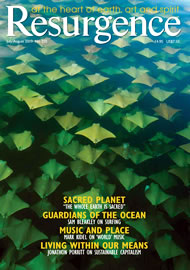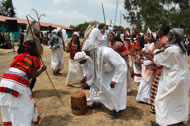AS WITH SO much of the so-called ‘developing’ world, it has long been assumed by Western-educated economists that local, traditional approaches to managing Nature belong to a by-gone era, and that countries like Ethiopia need to adopt Western ways. Not so, says Million Belay, director of the Addis Ababa-based Movement for Ecological Learning and Community Action (MELCA), and a leading light of the African Biodiversity Network.
Belay has watched as forest clearance and land degradation have decimated his country. He believes the situation is being made worse by a loss of traditional lifestyles and respect for elders and sacred sites. As Ethiopians become more Westernised, ancient beliefs which set out how to manage and relate to Nature are being eroded. “In the past, when people were sick they used to know how to find medicinal plants in forests or the compounds around their homesteads. But now they just go to clinics for a quick fix,” says Belay. He worries that in the future traditional knowledge will no longer be passed down from elders to younger generations. “The problem is not that Western knowledge is wrong,” says Belay, “but that when it is applied willy-nilly in countries like Ethiopia, disconnected from actual places and communities, it is ecologically and culturally blind and potentially dangerous.”
Rather than simply assuming that foreign, university-based experts know best, Belay has taken a home-grown approach, aimed at preserving traditional ecological knowledge before it disappears. Traditional ecological knowledge refers to a myriad of habitat-sensitive ways of relating to the ecosystems in which human communities live. For instance, in a 1,575km2 area of the vast Bale Mountains, MELCA has identified forty-eight ujuba or sacred forest areas where local people do not cut down trees. In another forested area in the Sheka zone, people must obtain permission before using the land. “These ‘dos and don’ts’ help bind the community together,” says Belay.
In the Bale Mountains, MELCA is conducting participatory, three-dimensional modelling with local communities to record traditional land uses and cultural attributes on maps. 3-D topographies are created using layers of cardboard on official government maps. Coloured pins and paints are added to show features like rivers, villages, forests and sacred areas. “In this way, biological and cultural diversity becomes real and easier for local people to understand,” Belay says.
SINCE 2006, MELCA has organised celebrations, working with schools, communities, youth groups and the government to keep Ethiopia’s ancient cultural legacy alive. The most recent celebration attracted 10,000 participants including the nation’s president. The event was a showcase for youth to demonstrate that their traditional ways of life contain valuable lessons about sustainable living. Young people from at least thirty-five schools participated and were encouraged to learn more about traditional approaches to environmental sustainability. “Learning happens when people prepare for celebrations,” says Belay. “We want to create a supportive environment in which elders can share their knowledge with the youth.”
To help achieve this, MELCA works with schools to set up ‘seed clubs’. “Cultural biodiversity revitalises our communities and builds youth leadership, developing leaders who will champion the protection of African biodiversity and community rights in the future,” Belay believes. The African Biodiversity Network also believes that the enhancement and protection of African biodiversity is embedded in cultural traditions which are being undermined by overly Westernised education. For a start, all secondary schooling is conducted in English, because there is an assumption that foreign knowledge is best. “As soon as children go to secondary school, respect for traditional beliefs begins to evaporate. Learning stops being related to students’ own lives and to the cultural traditions of the past. Due to narrow academic education, students could no longer identify a medicinal plant if their life depended on it,” Belay acknowledges.
The problem of diminishing cultural diversity boils down to education policy and the politics of precedence. Most policymakers are Western-educated and closer in thinking to the West, so they introduce policies that are divorced from Ethiopian communities and habitats. “Westernisation poses a big threat. We see it everywhere,” Belay says, “in the invasion of the media and satellite TV, and in the spread of cities. The force of Westernisation and globalisation is so pervasive, it’s hard to compete with it.”
SO WHAT DOES MELCA aim to achieve? “We are not foolishly thinking that all the old ways will come back. We are hoping for a blend of the old and the new,” Belay says. “Our hope is that at the end of the day, people will realise how important it is not to discard our traditional wisdom which has evolved over thousands of years.” MELCA encourages people to live in both worlds.
In the Indigenous language of the region, the word melca means ‘ford’, or a crossing point on a river. MELCA the organisation uses it symbolically to indicate the need to take people to a greater understanding and appreciation of traditional ecological knowledge, and also the need to navigate both the Western and the Indigenous ways of thinking. Now is the time to rebuild an ecology of knowledge which seeks to build on rather than obliterate the natural diversity of real peoples and places. •
See www.melca-ethiopia.org/ and The African Biodiversity Network: www.africanbiodiversity.org
Karl Hansen is director of the Living Rainforest Trust for Sustainable Living.







